The debate between Weber vs Napoleon grills has been around for some time. From the size and shape of the grills to their cooking capabilities, it can be difficult to decide which grill will fit your needs best. Weber grills have been a top choice for backyard barbecuers since the 1950s, while Napoleon grills are known for their modern styling and advanced technology.
In this article, we’ll look at the differences between these two brands and help you decide which is right for you. We’ll compare features such as Cooking Area, BTUs, Ignition System, Warranty, and Price Range so that you can make an informed decision before purchasing a Weber or Napoleon grill.
About Weber Grill
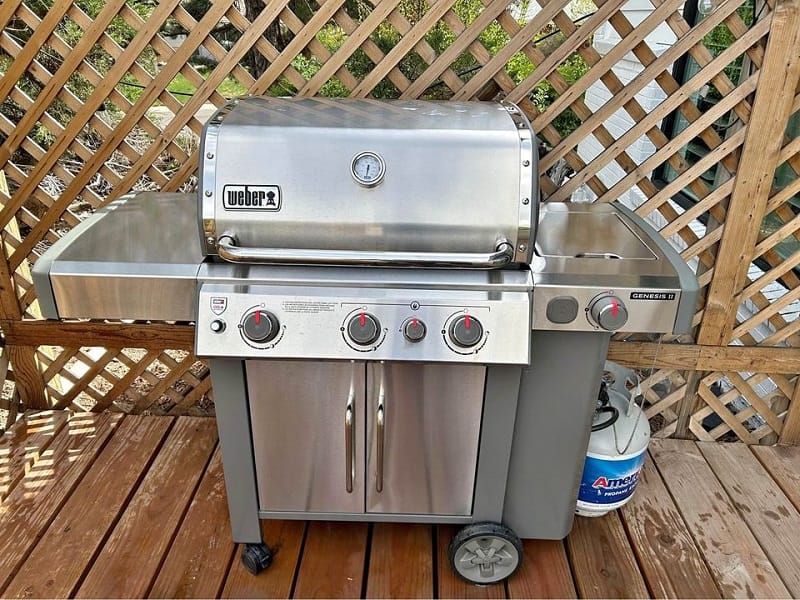
I’ve been an avid griller for as long as I can remember. I love the smell of charcoal and the sound of sizzling meat. It’s a hobby that brings me so much joy, and it’s become a staple in my life. That being said, I’ve gone through my fair share of grills, and I can confidently say that my Weber Grill is by far the best one I’ve ever owned.
Weber Grills have been around for over 60 years, and it’s easy to see why they’ve stood the test of time. Their grills are made with high-quality materials and are designed to last. I’ve had mine for several years, and it’s still in fantastic condition. The cast-iron grates are sturdy and hold heat well, and the porcelain-enameled lid and bowl are easy to clean and don’t rust.
One thing that sets Weber Grills apart from other brands is their versatility. They offer a range of different grills to fit any need, from small portable grills to large gas grills for a backyard barbecue. I have a Weber Kettle grill, perfect for cooking burgers, hot dogs, and even smoking meats.
What I love most about my Weber Grill is how consistent it is. The temperature control is precise, and I never worry about hot spots or uneven cooking. It makes grilling much easier and allows me to focus on cooking rather than constantly adjusting the heat.
Weber also offers a range of accessories and add-ons to enhance the grilling experience. I’ve purchased a few of these myself, including a grill light for nighttime grilling and a griddle for cooking breakfast foods.
About Napoleon Grill
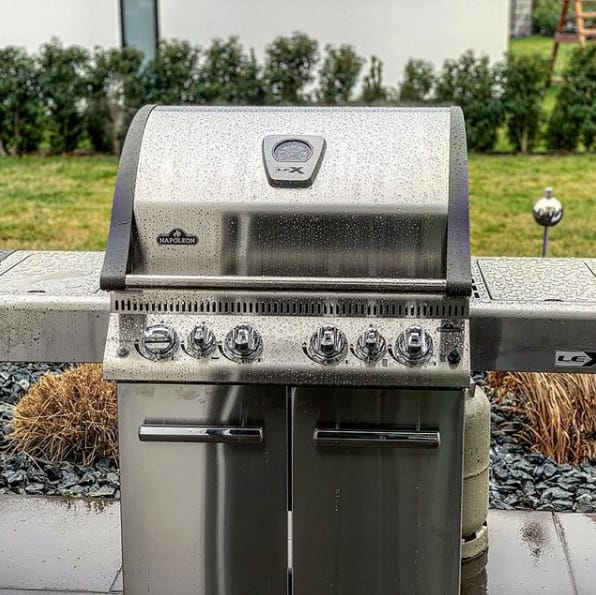
When it comes to Napoleon Grill, one thing that immediately caught my eye was the sleek and stylish design. The stainless steel finish not only looks great but it also makes for easy cleaning and maintenance. The grill also has various features, making it a standout choice for both novices and experienced grillers.
One of the features that impressed me the most was the dual-level cooking grids. This allows different types of food to be cooked simultaneously at different temperatures, making it perfect for hosting guests with different dietary needs. The grids also have a non-stick surface, making cleaning up any spills or grease easy.
Another feature that I found particularly useful was the built-in thermometer. This allowed me to monitor the temperature of my food without constantly opening the lid and losing heat. The grill also has a rear infrared burner, perfect for rotisserie cooking and creating that perfect sear on meats.
The Napoleon Grill also comes equipped with a range of accessories, including a cutting board, ice bucket, and condiment tray. This makes it easy to prepare and serve food all in one place. The grill has a built-in bottle opener to enjoy a cold beverage while cooking up a storm.
What Are The Similarities Between Weber And Napoleon Grills?
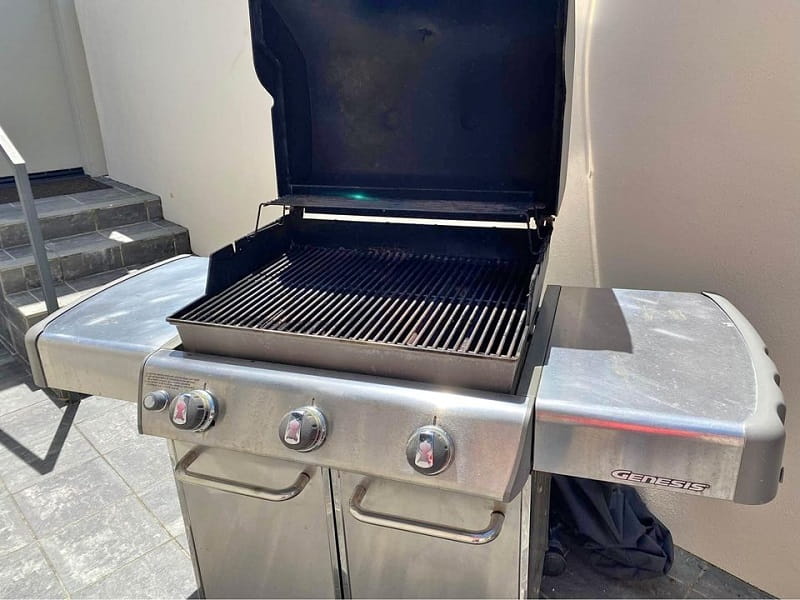
Weber and Napoleon are two well-known brands in the grill industry, and they share several similarities. Both brands started as metal works companies, with Weber originating in the United States and Napoleon in Canada. They both offer a wide range of grills and accessories, with a variety of price points available for consumers. Both brands also have long warranty durations and excellent customer support.
When it comes to features, both brands offer burners with comparable heat output and innovative technologies, such as ignition systems. Additionally, both brands provide a selection of grills with similar cooking space, allowing for efficient and quick outdoor cooking. Overall, while there may be some differences between the two brands, it’s clear that they both offer high-quality and durable grills for consumers.
What Are The Main Differences Between Weber Vs Napoleon Grills?
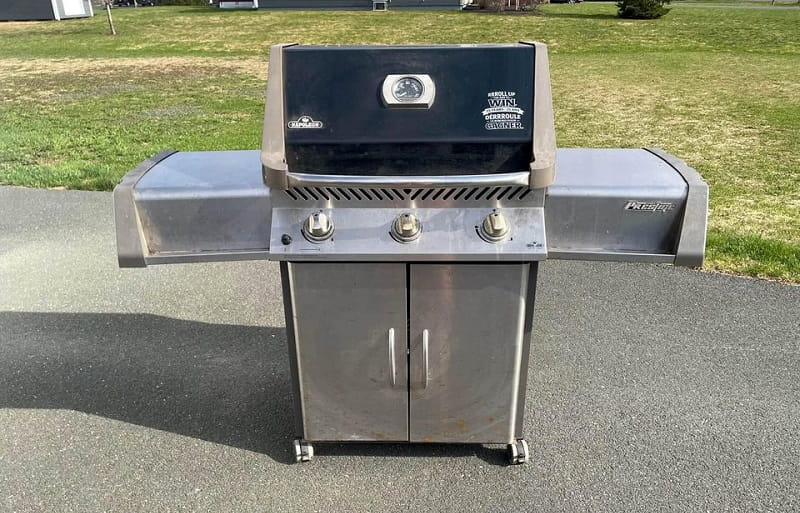
While both brands offer similar products, they differ in design, features, and performance. Weber grills are smaller and have a more classic design, while Napoleon grills offer more pizzazz with LED lights and chrome accents. Napoleon grills are built using thicker, more durable metal, often featuring side burners and warming racks. Weber grills have an excellent reputation for reaching high temperatures quickly, while many believe Napoleon grills are more consistent.
Weber has been in the business since the 1950s and still sells its kettle grills, while Napoleon is relatively new to the charcoal grill world. Weber is the choice for budget grills and charcoal models, while Napoleon is ideal for those looking for a high-end gas grill with extras like expanded cooking space, infrared burners, and rotisserie.
Ultimately, your chosen brand will depend on your budget and what you need for your grilling needs.
The Brands
While both brands offer high-quality grills, there are some notable differences between the two. Weber, an Illinois-based company, has been in the business since the 1950s and is known for its charcoal grills, including their iconic kettle grill. On the other hand, Napoleon, a Canadian company, is known for their high-end gas grills with features such as LED lights and chrome accents.
Size
Napoleon grills offer more cooking space than Weber grills, making them ideal for those who like to cook for large groups or families. Additionally, Napoleon models often feature more burners than Weber models, which provides added versatility when cooking. While Weber grills have outside gas tanks, Napoleon grills hide the gas tank inside all of their models, giving them a cleaner look.
Additionally, Napoleon grills tend to have at least one retractable side table, while most Webers do not. Finally, Napoleon’s 2-piece lids retain more heat and provide better wind resistance than most Weber lids, making them ideal for those in windy areas. Overall, while both brands offer similar grilling experiences, those looking for more cooking space and added features may prefer a Napoleon grill over a Weber grill.
Read more:
- Traeger Vs Green Egg
- Traeger Vs Pit Boss
- Smoker Vs Pellet Grill
- How To Remove Rust From Grill Grates
- Camp Chef Vs Blackstone
- Griddle Vs Grill
Cooking Space
Regarding cooking space, both Weber and Napoleon offer a range of options across their grill lines. Napoleon’s Rogue 425 gas grill boasts 570 sq inches of cooking space – with 425 sq inches on the main grill grates – while Weber’s Spirit II E-310 gas grill offers a slightly smaller cooking area at 529 sq inches. For those in need of more room, both companies have high-end models that feature larger cooking spaces, such as Napoleon’s Prestige 900 with 900 sq inches and Weber’s Summit Charcoal Grill with 580 sq inches.
Build Quality And Durability
Napoleon grills are often built with thicker and more durable metal, making them more robust. They may also include features like side burners and warming racks, adding to their durability and convenience. On the other hand, Weber grills have a reputation for reaching high temperatures quickly, making them ideal for searing and grilling. While both brands use high-quality materials and expert craftsmanship, consumers may prefer one brand over the other based on individual preferences for build quality and durability.
Weber Vs Napoleon Grills: Price
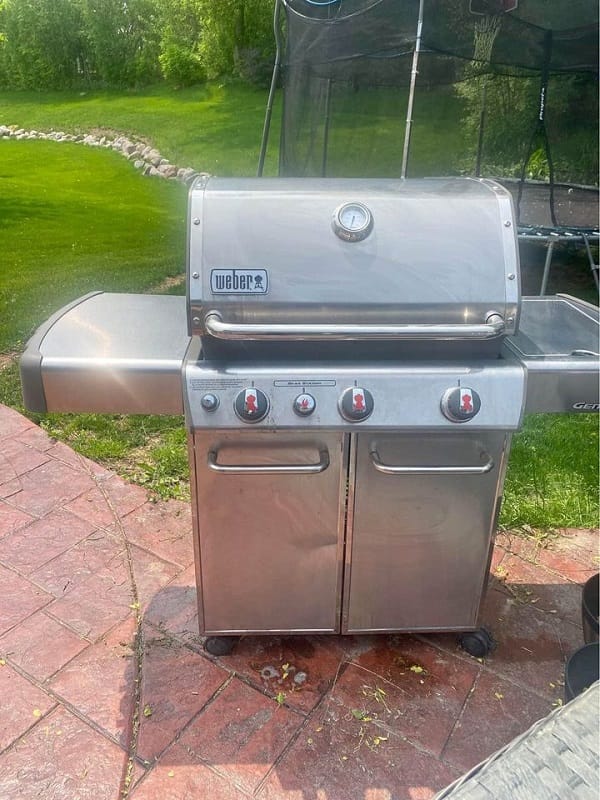
When it comes to the price of Weber vs Napoleon grills, both brands offer models with similar price points. However, it’s typically found that Napoleon offers comparable products to Weber for a lower price. If you spend the same amount of money on both brands, you’re more likely to end up with a more feature-rich model if you go with Napoleon.
Additionally, Napoleon grills often come with longer warranties that cover all components and parts, which is a major factor to consider when purchasing. Overall, if cost is a primary concern, Napoleon may be the better choice due to its lower prices and longer warranties.
Heating
Weber and Napoleon’s grills have their strengths and weaknesses when it comes to heating. Weber grills are known for their ability to reach high temperatures quickly, which is great for searing steaks. On the other hand, Napoleon grills are known for being more consistent with their temperature levels. This is due to their thicker, more durable metal construction and ability to feature side burners and warming racks for keeping food warm while the main grill is being used.
Both brands utilize top-quality materials and expert craftsmanship, but it ultimately comes down to personal preference and the specific model used. Whether you prefer Weber’s quick heating capabilities or Napoleon’s consistency, both brands have an excellent reputation for heating and producing delicious grilled meals.
Performance
Weber grills are known for their ability to reach high temperatures quickly, making them ideal for searing and quick grilling. On the other hand, Napoleon grills are built using thicker and more durable metal, making them more consistent in temperature and better for slow roasting and smoking. Additionally, Napoleon grills often feature side burners and warming racks for keeping food warm while grilling on the main grill. Weber grills, meanwhile, are smaller in size with a more classic design, while Napoleon grills have a more modern and high-end look with LED lights and chrome accents.
Temperature Range
Weber grills are known for reaching high temperatures quickly, whereas many people believe Napoleon grills are more consistent. Each brand has its benefits for different types of cooking, and it varies depending on the model being used. However, it’s important to note that both Weber and Napoleon offer a range of grills with varying temperature ranges to suit different cooking needs and preferences.
Ignition System
Weber grills typically have a more traditional ignition system, often using a push-button or electronic ignition. On the other hand, Napoleon grills often feature the JETFIRE ignition system, which uses a jet of flame to ignite the burners. This system is said to be more efficient and reliable than traditional ignition systems, as it doesn’t rely on electrical components that can wear out or malfunction. However, it’s important to note that both Weber and Napoleon grills are generally known for their high-quality and reliable ignition systems, so the choice may ultimately come down to personal preference.
Grilling Accessories And Aftermarket Parts
When it comes to grilling accessories and aftermarket parts, both Weber and Napoleon offer a wide range of options to enhance and customize your grill. Weber has a long history of producing accessories, with some of their most popular options including grill covers, flavorizer bars, and rotisserie kits. They also offer custom grilling grates, tool sets, and temperature probes. Napoleon also provides a strong selection of accessories, including smoker tube kits, grilling baskets, and grill brushes.
In terms of aftermarket parts, Weber offers replacement parts for all of their grill models, including burners, cooking grates, and ignition systems. Napoleon also provides replacement parts for their grills, focusing on superior quality and durability. Customers can expect to find a wide range of options from both brands, with Weber offering slightly more options overall. Still, Napoleon provides higher-end and more innovative accessories and parts.
Weber Grills Vs Napoleon: Ease Of Use
When it comes to ease of use, both Weber and Napoleon grills offer user-friendly features. However, Weber grills have an edge with their one-touch cleaning system, simplifying the cleanup process. Additionally, the Weber Connect Smart Technology upgrade allows real-time food monitoring through a mobile device, making the grilling process easier and more efficient.
On the other hand, Napoleon grills boast easy assembly, with their grills being easy enough for one person to put together in about an hour. They also offer fold-down side shelves and tool hooks, which save space when storing the grill.
Which Brand Is Better Suited For Outdoor Cooking, Weber Or Napoleon?
Napoleon models generally offer more cooking space and extra burners, which means more cooking heating and versatility. Napoleon’s Jetfire ignition system is also considered ahead in terms of effectiveness, reliability, and durability. Another design difference is the gas tank placement, with Napoleon hiding it inside all models and having retractable side tables, which provides a cleaner look.
Napoleon’s 2-piece lids retain more heat and provide better wind resistance than most Weber lids, a factor that can be crucial in locations where the wind is a challenge. If you spend a similar amount of money with both brands, you’ll likely end up with a more feature-rich model if you go with Napoleon. Furthermore, Napoleon grills usually edge out the warranty offering from Weber by a few years and cover the entirety of the grill, including all of its components and parts.
Maintenance And Cleaning
Weber and Napoleon’s grills require regular maintenance and cleaning to ensure longevity and performance. One important difference between the two is the accessibility and design of their parts. Weber grills have standardized parts, making repairs and replacements more convenient. On the other hand, Napoleon grills have specialized and intricately designed parts that require more specific knowledge and expertise for maintenance.
Both brands recommend regular cleanings after each use, but Napoleon grills offer more accessible grease trays and burners for easier cleaning. Weber grills, however, have a system for ash removal in their charcoal grills. It is also important to note that Weber has a line of self-cleaning grills, which use a high-heat mode to burn off residue without requiring manual cleaning.
Warranty
Napoleon grills come with a longer warranty period than Weber grills. For instance, the Napoleon Rogue 425 gas grill comes with a 15-year warranty, covering everything from the grill lid to the bottom of the cart, while the Weber Spirit II E-310 gas grill only has a ten-year warranty.
Additionally, Napoleon offers a lifetime warranty for some of its parts, such as the stainless steel burners and sear plates, indicating their confidence in their product’s durability. In contrast, Weber’s warranty emphasizes customer service, offering to resolve issues and fix problems even outside the warranty period.
Which Brand Offers A Wider Range Of Grilling Options, Weber Or Napoleon?
When offering a wider range of grilling options, it is safe to say that Napoleon takes the lead. Napoleon models offer more cooking space, burners with comparable heat output, and additional burners for heating and versatility. Napoleon grills also feature the Jetfire ignition system, which is more effective, reliable, and durable compared to Weber’s Infinity ignition system.
In terms of design, Napoleon grills have the gas tank hidden inside, making for a cleaner look, while Weber grills have it located outside. The 2-piece lids on Napoleon grills provide better heat retention and wind resistance than most Weber lids. Additionally, Napoleon offers a more feature-rich model for a lower price compared to Weber, making it an excellent option for those who want a quality grill without breaking the bank.
Which Is Better: Vs Napoleon vs Weber Grills?
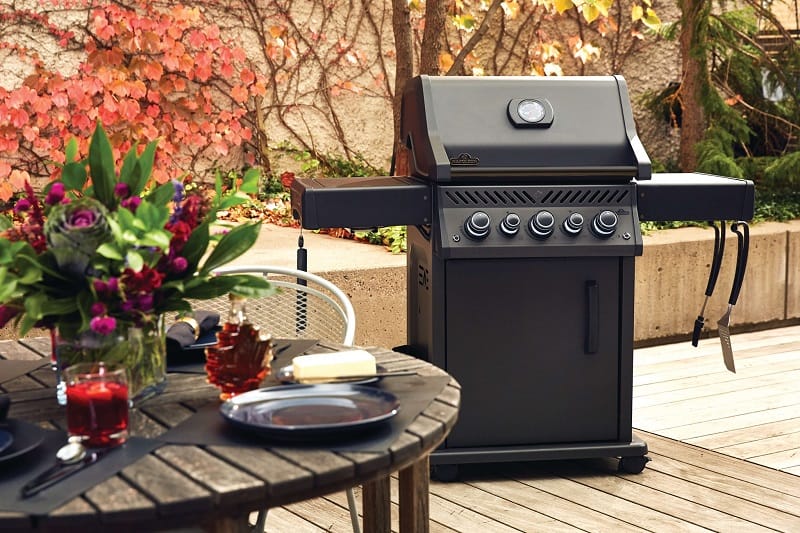
While both brands use high-quality materials and expert craftsmanship, Weber has been in the business since the 1950s and still sells its kettle grills, making them the ideal choice for charcoal. In comparison, Napoleon is relatively new to the charcoal grill world but has a reputation for offering high-end gas grills with all the trimmings. Overall, the best choice between Weber and Napoleon will depend on the user’s needs, budget, and preferences.
What Are Gas Grills, And How Do They Work Compared To Other Types Of Grills Like Charcoal Grills?
Gas grills are popular for outdoor cooking enthusiasts due to their convenience and ease of use. A gas grill uses propane or natural gas as a fuel source to generate heat for cooking food. It typically has a lid, a cooking grate, burners, and a fuel source (usually a propane tank or a natural gas line). Gas grills are known for their convenience, as they can be turned on and off easily and heat up quickly. They are also easy to clean, as there is no ash.
Now, how do gas grills work compared to charcoal grills? Charcoal grills use charcoal briquettes or lump charcoal as a fuel source. The charcoal is lit and burns, generating heat for cooking food. Charcoal grills can take longer to heat up and require more effort to get started than gas grills. They also require more attention during cooking, as the temperature can be difficult to control.
In terms of flavor, many people believe that charcoal grills produce a smokier, more authentic BBQ flavor than gas grills. However, gas grills can still produce delicious and flavorful food. Some gas grills even have smoke boxes or burners that allow you to add wood chips for added flavor.
Regarding cost, gas grills can be more expensive initially than charcoal grills. However, they may save you money in the long run, as propane and natural gas tend to be cheaper than charcoal. Gas grills also last longer and require less maintenance than charcoal grills.
What Are The Pros And Cons Of Having The Gas Tank Placed Inside Or Outside The Grill, And Which Option Is Better For Weber And Napoleon Grills?
When it comes to grilling, the placement of the gas tank can make a big difference in the overall experience. Here, I will share my first-hand experience and provide a matter-of-fact analysis of the pros and cons of placing the gas tank inside or outside the grill and which option is better for Weber and Napoleon grills.
Inside Gas Tank Placement
Pros:
- Sleek look: grills with inside gas tank placement often have a more streamlined, modern appearance.
- Protected from elements: the gas tank is shielded from rain, snow, and other weather conditions that could affect its performance.
- Better mobility: without the gas tank hanging off the side, the grill is often easier to move around.
Cons:
- Limited space: the gas tank takes up valuable space inside the grill, making it harder to cook large or multiple items at once.
- Inconvenient refill process: refilling the gas tank requires removing the entire grill top, which can be a hassle.
- Higher price: grills with inside gas tank placement tend to be more expensive than those with outside placement.
Outside Gas Tank Placement
Pros:
- More cooking space: with the gas tank located outside the grill, there is more room inside for cooking.
- Easy refill process: refilling the gas tank is as simple as disconnecting it and taking it to the store for a refill.
- Lower cost: grills with outside gas tank placement are typically less expensive than those with inside placement.
Cons:
- Exposed to elements: the gas tank is more susceptible to damage from rain, snow, and other weather conditions.
- Less mobility: the gas tank can make the grill less maneuverable and harder to move around.
- Less sleek appearance: grills with outside gas tank placement often have a bulkier, less modern look.
So, which option is better for Weber and Napoleon grills? In my experience, it ultimately comes down to personal preference and usage. If you prioritize a sleek appearance and don’t mind sacrificing a bit of cooking space, an inside gas tank placement may be the way to go. However, an outside gas tank placement may be better if you plan on cooking large or multiple items at once. Additionally, if you live in an area with harsh weather conditions, an inside gas tank placement may provide more protection for your grill and gas tank.
In conclusion, inside and outside gas tank placement options have pros and cons. It’s essential to weigh these factors and consider your needs and preferences before deciding. As for me, I currently prefer the outside gas tank placement for my grill, but who knows – my opinion may change in the future.
FAQs About Weber Vs Napoleon Grills
Who Are The Top Manufacturers Of Gas Grills In The Market Today?
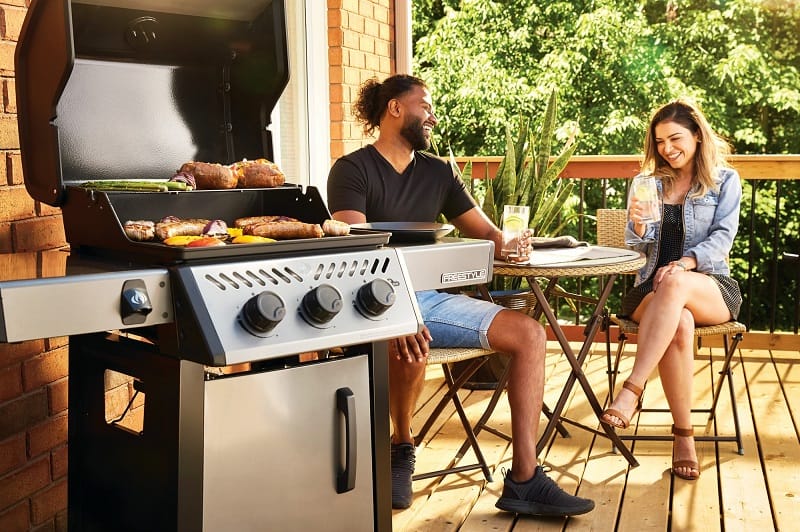
According to experts, Weber, Char-Broil, Napoleon, and Traeger are some of the top gas grill manufacturers today.
- Weber is known for its durable build quality and porcelain-enameled cast iron grates that heat evenly.
- Char-Broil is praised for its Tru-Infrared technology, which prevents flare-ups and maintains consistent heat.
- Napoleon offers a wide range of gas grills with varying sizes and features, including side and infrared burners.
- Traeger is a leading manufacturer of pellet grills that use wood pellets to provide unique smoky flavors to the food.
These manufacturers have been tested and reviewed by experts, ensuring that consumers can make an informed decision when purchasing a gas grill.
Napoleon Rogue XT 425 Vs Weber Spirit E 330
Both models have unique features. Napoleon Rogue XT 425 comes with powerful burners capable of producing 45000 BTUs, while Weber Spirit E 330 generates 32,000 BTUs from its three burners. Napoleon’s grill uses wave-shaped grates that offer a distinctive cooking style, while Weber uses porcelain-enameled cast iron cooking grates for durability. Napoleon’s grill features a rear infrared burner ideal for rotisserie cooking, while Weber’s offers a sear station burner that generates high heat.
In terms of cooking surface, Napoleon’s grill provides 815 sq. inches of cooking space, while Weber’s offers 529 sq. inches. Both models come with foldable side shelves for easy storage, but Napoleon’s grill has an enclosed cabinet that provides additional storage space.
Napoleon Grills Prestige 500 Vs Weber Genesis
When comparing the Napoleon Grills Prestige 500 to the Weber Genesis, it’s important to note that both companies are well-established in the gas grill industry, has similar features, and are manufactured by Wolf Steel Canadian. However, Napoleon is known as the Weber of Canada and is North America’s largest privately owned grills and fireplaces manufacturer. While older Weber models were manufactured in the USA, newer models, including the Genesis, are imported from overseas.
The Napoleon Prestige 500 offers a lifetime warranty on many components with a 15-year warranty on all other parts. The Weber Genesis offers a 10-year warranty on many components, but recent models have reduced the warranty from 25 years down to 10 years overall.
While the Virtual Weber Bulletin Board reviewed both grills, some viewers noted a potential issue with the rotisserie burner on the Napoleon model, which appeared to be heating unevenly. However, in terms of overall build quality and value, the Napoleon Prestige 500 has been praised for its sturdiness and features, including illuminated knobs and a rear sear burner.
Conclusion
Ultimately, the choice between Weber vs Napoleon grills comes down to personal preference, budget, and needs. Both brands offer excellent grills built to last and deliver exceptional performance. Weber is known for its durability, performance, and ease of use, while Napoleon is known for its quality, innovation, and performance. So, whether you choose Weber or Napoleon, you can be sure you are getting a quality grill that will give you years of grilling pleasure.
References:

Hey readers! Chip Holland here, and I’m a Manager of this website. My passion for writing about it only matches my passion for BBQ. Follow my blog for mouth-watering recipes, tips, and tricks for the perfect smoke, grill, and BBQ. I’m sure you won’t be disappointed!
